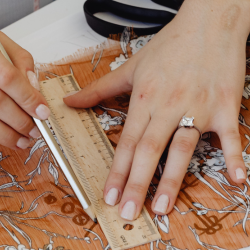Resin jewelry making is a captivating craft that blends creativity with human technical skill, allowing artists to create stunning, one-of-a-kind pieces. By combining epoxy resin with pigments, inclusions like glitter and various molds and you can craft jewelry that ranges from minimalist designs to vibrant looks based on the requirement and skin tone by intricate works of art. This guide will walk you through the entire process, from selecting materials to finishing your pieces, making it accessible for beginners and inspiring for seasoned crafters.
The appeal of resin jewelry lies in its versatility and durability in the material. Unlike traditional materials, resin allows for endless customization of the jewelry, enabling you to embed personal mementos or experiment with colors and textures. Whether you’re drawn to creating sparkling pendants, elegant earrings, or bold statement rings, this guide provides the essential steps, tips, and techniques to help you master the art of resin jewelry making with confidence.
Table of Content
- How to Make Resin Jewelry – A Complete Guide
- What is Resin Jewellery?
- Examples Of Resin Jewellery
- Step-by-Step Guide To Make Resin Jewellery
- Step 1: Get All the Materials Ready for Resin Jewelry
- Step 2: Prepare Your Molds or Bezels and Decorations
- Step 3: Mix the Resin Properly
- Step 4: Pour the First Layer of Resin Into the Mold
- Step 5: Place Your Decorative Items in the Resin
- Step 6: Add More Layers of Resin If Needed
- Step 7: Carefully Remove the Jewelry from the Mold
- Step 8: Attach the Jewelry Parts (Like Hooks or Chains)
- What is the difference between resin and epoxy jewellery?
- Conclusion
- FAQs
What is Resin Jewelry?
Resin jewelry is a unique form of handmade accessory crafted using epoxy or UV resin which is a clear, durable material that hardens into a glass-like finish after the procedure. This versatile medium allows artists to embed a wide range of decorative elements such as dried flowers, glitter, stones, beads, gold foil, and even miniature objects, making each piece a miniature work of art. Resin jewelry comes in various styles and forms, including pendants, earrings, rings, bangles, and statement pieces, each reflecting creativity and craftsmanship. Loved for its vibrant colors, lightweight feel, and customizability, resin jewelry has become a favorite in the world of DIY fashion and contemporary accessories.
Examples of Resin Jewelry
Resin jewelry offers endless creative possibilities, with styles ranging from elegant to whimsical. Here are some popular examples:
- Dried Flower Resin Pendants
Encasing real flowers in crystal-clear resin, these pieces preserve nature’s beauty in a timeless form. - Ocean-Themed Resin Rings
Featuring waves, sand, and tiny shells, these designs bring beachy vibes and vacation memories to life. - Gold Foil Resin Earrings
Infused with metallic leaf, these earrings offer a luxurious shimmer perfect for festive or evening wear. - Glow-in-the-Dark Resin Bracelets
Fun and futuristic, these pieces absorb light and glow in the dark—ideal for parties or nightwear. - Photo-Embedded Resin Lockets
Personal and meaningful, these include tiny photographs sealed in resin to keep memories close. - Geometric Resin Studs
Minimalist and modern, geometric shapes filled with resin in bold colors are a chic fashion statement. - Pressed Leaf Resin Bangles
Featuring delicate leaves or ferns, these bangles offer a fresh, organic touch.
Resin Jewelry Guide
Glitter Resin Jewelry
Glitter resin jewelry, a popular form of resin art jewelry, incorporates sparkly particles into epoxy resin jewelry for a dazzling effect. Mix fine or chunky glitter into the resin before pouring into resin jewelry molds to create shimmering pendants, earrings, or rings. Use non-bleeding glitter to maintain clarity in your resin jewelry ideas.
Pressed Leaves or Flower Jewelry
This style of resin jewelry embeds dried, pressed leaves or flowers into clear resin, preserving their natural beauty. Use a resin jewelry kit to ensure you have all jewelry design tools, like molds and mixing cups, for making resin jewelry. Seal botanicals with a thin resin layer to prevent clouding in epoxy resin jewelry.
Leaf Skeleton Jewelry
Leaf skeleton jewelry, a unique resin jewelry idea, uses translucent leaf veins embedded in resin for an ethereal look. These delicate structures require careful handling in resin jewelry molds to avoid tearing. Clear epoxy resin jewelry highlights their fragility, making them a standout in resin art jewelry.
Colored Resin
Colored resin jewelry involves adding pigments, dyes, or mica powders to resin for vibrant effects. Alcohol-based dyes create translucent hues, while mica powders add metallic shimmer. A resin jewelry kit often includes pigments for experimenting with resin jewelry ideas. Mix sparingly to ensure proper curing.
Clay Jewelry with Resin Coating
Shape polymer or air-dry clay into beads or pendants, then coat with epoxy resin jewelry for durability and gloss. The resin enhances texture and protects the clay. Use resin jewelry molds for uniform shapes, and ensure clay is cured before applying resin for your resin art jewelry project.
Alcohol Ink Design and Resin
Alcohol inks create fluid, abstract designs in resin jewelry, perfect for unique resin jewelry ideas. Drop inks into wet resin and manipulate with toothpicks for swirls. Seal with a clear epoxy resin jewelry topcoat to protect the vibrant patterns, achievable with a resin jewelry kit.
Opal, Wood, and Resin
Combining crushed opal or wood with resin creates organic resin art jewelry. Opal adds iridescent sparkle, while wood offers earthy textures. Sand wood inclusions and use clear epoxy resin jewelry in resin jewelry molds to highlight natural elements, ideal for making resin jewelry with a luxurious feel.
Gemstones
Embed small gemstones like amethyst or turquoise in resin jewelry for elegance. Tumbled stones work best in resin jewelry molds, ensuring durability. Arrange strategically for visibility in epoxy resin jewelry, a popular technique in resin jewelry ideas for professional-looking pieces.
Also Read About: Types of Jewelry Design
Step-by-Step Guide To Make Resin Jewellery
Step 1: Get All the Materials Ready for Resin Jewelry
Gather a resin jewelry kit containing epoxy resin jewelry, hardener, mixing cups, stir sticks, resin jewelry molds, gloves, safety mask, decorations (glitter, flowers), and findings (hooks, chains). Work in a dust-free, ventilated area for making resin jewelry.
Step 2: Prepare Your Molds or Bezels and Decorations
Clean resin jewelry molds or bezels with isopropyl alcohol. Pre-arrange decorations like flowers or gemstones to fit your resin jewelry ideas. Coat delicate items with resin to prevent bubbles in epoxy resin jewelry.
Step 3: Mix the Resin Properly
Mix epoxy resin jewelry and hardener in the correct ratio (usually 1:1 or 2:1) using tools from a resin jewelry kit. Stir slowly for 3–5 minutes to avoid bubbles. Add pigments or glitter for resin art jewelry, and use a heat gun to remove bubbles.
Step 4: Pour the First Layer of Resin Into the Mold
Pour a thin layer of resin into resin jewelry molds to create a base. This secures decorations and prevents sinking in epoxy resin jewelry. Let it cure to a tacky stage (2–4 hours) before proceeding with making resin jewelry.
Step 5: Place Your Decorative Items in the Resin
Using tweezers, place flowers, glitter, or gemstones into the tacky resin in resin jewelry molds. Ensure proper positioning for your resin jewelry ideas without overcrowding. Press gently to secure in epoxy resin jewelry.
Step 6: Add More Layers of Resin If Needed
Pour additional resin layers to encase decorations in resin jewelry, letting each layer cure partially. This prevents uneven distribution in epoxy resin jewelry. Fill resin jewelry molds to the desired level for a smooth finish.
Step 7: Carefully Remove the Jewelry from the Mold
After full curing (24–48 hours), flex resin jewelry molds to release the resin jewelry. For rigid molds, use a release spray. Sand rough edges for a polished epoxy resin jewelry finish.
Step 8: Attach the Jewelry Parts (Like Hooks or Chains)
Attach findings like hooks or chains using jewelry glue or by drilling holes in resin jewelry. Ensure secure connections for a professional resin art jewelry piece, completing your making resin jewelry process.
Know About: Jewelry Design Course
What is the difference between resin and epoxy jewellery?
| Aspect | Resin Jewelry | Epoxy Jewelry |
| Composition | General term for resins (polyester, polyurethane, epoxy). Often polyester-based for resin jewelry. | Uses epoxy resin jewelry, a two-part system (resin + hardener). |
| Curing Time | Varies; polyester resin may take 12–24 hours for resin art jewelry. | Epoxy resin jewelry cures in 24–48 hours, with fast-curing options in 6–12 hours. |
| Clarity and Finish | Polyester resin may yellow; less clear in resin jewelry. | Epoxy resin jewelry offers high clarity, UV-resistant, glossy finish. |
| Ease of Use | Polyester resin is trickier, with more bubbles and odor in making resin jewelry. | Epoxy resin jewelry is user-friendly, with fewer bubbles and easier mixing. |
| Cost | Cheaper for resin jewelry but may need more equipment. | Epoxy resin jewelry is pricier but preferred for quality. |
| Applications | Budget-friendly resin jewelry for less intricate designs. | Professional, clear epoxy resin jewelry for intricate resin jewelry ideas. |
Conclusion
Resin jewelry, particularly epoxy resin jewelry, offers endless creative possibilities, from glitter to gemstones. Using a resin jewelry kit and resin jewelry molds, making resin jewelry is accessible for all skill levels. Understanding resin types, like epoxy versus polyester, ensures the best results for your resin art jewelry. With proper techniques, you can craft durable, unique resin jewelry ideas that stand out.
FAQs
1. Is resin a good material for jewelry?
Yes, resin jewelry is versatile, durable, and ideal for encasing elements like flowers or gemstones. Epoxy resin jewelry offers superior clarity and strength for professional resin art jewelry.
2. Is wearing resin jewelry safe?
Fully cured resin jewelry is safe, as the material becomes inert. Ensure proper curing (24–48 hours) when making resin jewelry to avoid irritation from uncured resin.
3. Why is resin so expensive?
High-quality epoxy resin jewelry is costly due to its clarity, UV resistance, and formulation. Resin jewelry kits and resin jewelry molds add to costs, though polyester resin is a cheaper alternative.
4. Is resin jewellery waterproof?
Fully cured resin jewelry is waterproof, making it suitable for daily wear. Avoid prolonged water exposure to maintain the finish of epoxy resin jewelry.
























